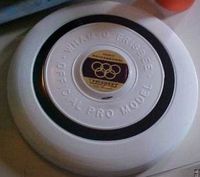Difference between revisions of "AY Honors/Ultimate Disc/Answer Key"
(No difference)
|
Revision as of 16:10, 5 November 2006

Flying discs (commonly called Frisbees) are the general name for any number of discs which are generally plastic, roughly 20 to 25 centimeters (8–10 in) in diameter, with a lip. They are designed to fly aerodynamically when thrown with rotation and can be caught by hand. The name Frisbee is a registered trademark of the Wham-O toy company, but the term is often used generically to describe all versions of the flying disk.
A wide range of flying disk variants are available commercially. Disc golf disks are usually smaller but denser and are tailored for particular flight profiles to increase/decrease stability and distance. When it was discovered that dogs enjoyed chasing and retrieving the slow-moving disks, special disks were designed with more pliable material that would better resist a dog's bite, and prevent possible injury that may occur with more rigid materials. Disc dog competitions, in which dogs' disk-catching skills are judged, have become quite popular as well. Ring-like disks shaped like a Saturn's ring, known as Aerobies, typically fly significantly farther than any traditional flying disk. The evolution has continued with the advancement of lighting a flying disk for evening and night-time play. By using a Flashflight disk, players can extend the throw and catch playing time after the sun goes down.
History
People have been throwing cake pans, pie tins, cookie jar lids, and other such objects for centuries. The clay target used in trapshooting is almost identical to a flying disk in shape, but was designed in the 19th century. The modern day flying disks, however, began when people started making them out of plastic, and modern flying disks are developed from the "Flying-Saucer", originally invented by Fred Morrison and co-developed and financed by Warren Franscioni in 1948. However, that initial disk was largely unsuccessful. A later model made by Morrison in 1955 and sold as the "Pluto Platter" was bought by Wham-O on January 13, 1957. In the next year, Wham-O renamed the toy "Frisbee", a (probably deliberate) misspelling of the name of the Frisbie Pie Company of Bridgeport, Connecticut, whose pie tins had been used by Yale University students in the campus for similar purposes.
Games using flying discs
- Ultimate
- Freestyle frisbee
- Disc Golf - the traditional game of Golf played with flying discs (frisbees) instead of clubs and balls.
- Durango Boot
- Double Disc Court
- Guts Frisbee
- Flutterguts, also known as Flutter Frisbee
- Friskee
- Disc dog
- Dodge Frisbee
- Goaltimate
- Schtick
- Fricket, also known as Cups
- Hot Box
- Fris-Nok, the traditional Icelandic-Canadian game.
- Extreme Frisbee, a less official, more violent game.
- Speed Frisbee, like a tennis game with a disc.
- Splendid Frisbee, a little-known, noncompetitive running game
Physics
The rotating flying disk has angular momentum perpendicular to the horizontal plane, stabilizing the disk's attitude in high-speed flight. Small ridges near the leading edge act as turbulators, reducing flow separation by forcing the airflow to become turbulent after it passes over the ridges. Lift is generated in primarily the same way as a traditional asymmetric airfoil, that is, by accelerating upper airflow such that a pressure difference gives rise to a lifting force.
Even a slight deformation in a disk, called a "taco" as extreme cases look like a taco shell, can cause adverse affects when throwing long range. It can be observed by holding the disk horizontally at eye level and looking at the rim while slowly rotating the disk.
Trivia
- In the animated motion picture The Secret of NIMH, the main character's name was changed in post-production from "Frisby" to "Brisby" to avoid potential trademark infringements.
- In the film Back to the Future Part III, Marty McFly throws a metal pie dish at a gunman in order to save Doc Brown's life. He notices the dish is stamped "Frisbee Pie Company", giving a fictional origin to the current use of the term.
- Richard Feynman in his book Surely You're Joking, Mr. Feynman! suggests that watching the wobble of a plate tossed in the Cornell University cafeteria stimulated him to develop mathematics that eventually led to his Nobel prize winning work in quantum electrodynamics [1].
See also
Further reading
- Frisbee, A Practitioner's Manual and Definitive Treatise Stancil E.D. Johnson, M.D. Workman Publishing Company, New York (July, 1975) ISBN 0-911104-53-4
- The Official Frisbee Handbook Goldy Norton, Bantam Books, Toronto/New York/London (July, 1972) no ISBN
- Frisbee Players' Handbook Mark Danna, Dan Poynter, Parachuting Publications, Santa Barbara, California (1978) ISBN 0-015516-19-5
- Frisbee Sports & Games Charles Tips, Dan Roddick, Celestial Arts, Millbrae, California (March 1979) ISBN 0-89087-233-3
- Frisbee by the Masters Charles Tips, Celestial Arts, Millbrae, California (March 1977) ISBN 0-89087-142-6
- Spinning Flight : Dynamics of Frisbees, Boomerangs, Samaras and Skipping Stones, Ralph Lorenz, Copernicus New York, September 2006 ISBN 0-38730-779-6
External links
- Frisbee, about.com
- Ultimate Players Association sports governing body of Ultimate in the USA
- World Flying Disc Federation international sports governing body for all
Europe
- [2] Freespect-Belgian frisbee team
flying disc sports
- Discraft manufacturer of flying discs for Ultimate, Disc Golf, and Freestyle
- Wham-O Frisbee disc website manufacturer of Frisbee brand flying discs
- UK Ultimate Association
- frisbeecollective.com
cs:Frisbee da:Frisbee de:Frisbee es:Frisbee eo:Flugdisko fr:Frisbee it:Frisbee nl:Frisbee ja:フライングディスク no:Frisbee pl:Frisbee sk:Frisbee sr:Frizbi sv:Frisbee uk:Фрісбі
